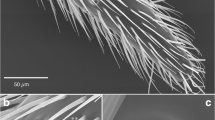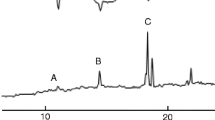Abstract
We investigated the female-produced sex pheromone of the solitary bee Andrena nigroaenea and compared it with floral scent of the sexually deceptive orchid Ophrys sphegodes which is pollinated by Andrena nigroaenea males. We identified physiologically and behaviorally active compounds by gas chromatography with electroantennographic detection, gas chromatography-mass spectrometry, and behavioral tests in the field. Dummies scented with cuticle extracts of virgin females or of O.sphegodes labellum extracts elicited significantly more male reactions than odorless dummies. Therefore, copulation behavior eliciting semiochemicals are located on the surface of the females' cuticle and the surface of the flowers. Within bee and orchid samples, n-alkanes and n-alkenes, aldehydes, esters, all-trans-farnesol and all-trans-farnesyl hexanoate triggered electroantennographic responses in male antennae. Most of the alkanes and alkenes occurred in similar patterns both in the bees and orchids. O. sphegodes leaf extracts contained mostly the same compounds but in different proportions. In behavioral tests with synthetic compounds, blends of alkenes triggered significantly more approaches and pounces of the males whereas alkanes were not more attractive than odorless dummies. Since alkanes and alkenes together were most attractive, we conclude they constitute the bees' sex pheromone as well as the pseudocopulation-behavior releasing orchid-odor bouquet.
Similar content being viewed by others
Author information
Authors and Affiliations
Additional information
Accepted: 30 March 2000
Rights and permissions
About this article
Cite this article
Schiestl, F., Ayasse, M., Paulus, H. et al. Sex pheromone mimicry in the early spider orchid (Ophrys sphegodes): patterns of hydrocarbons as the key mechanism for pollination by sexual deception. J Comp Physiol A 186, 567–574 (2000). https://doi.org/10.1007/s003590000112
Issue Date:
DOI: https://doi.org/10.1007/s003590000112




